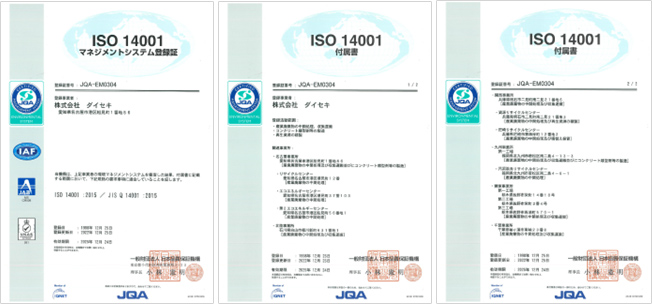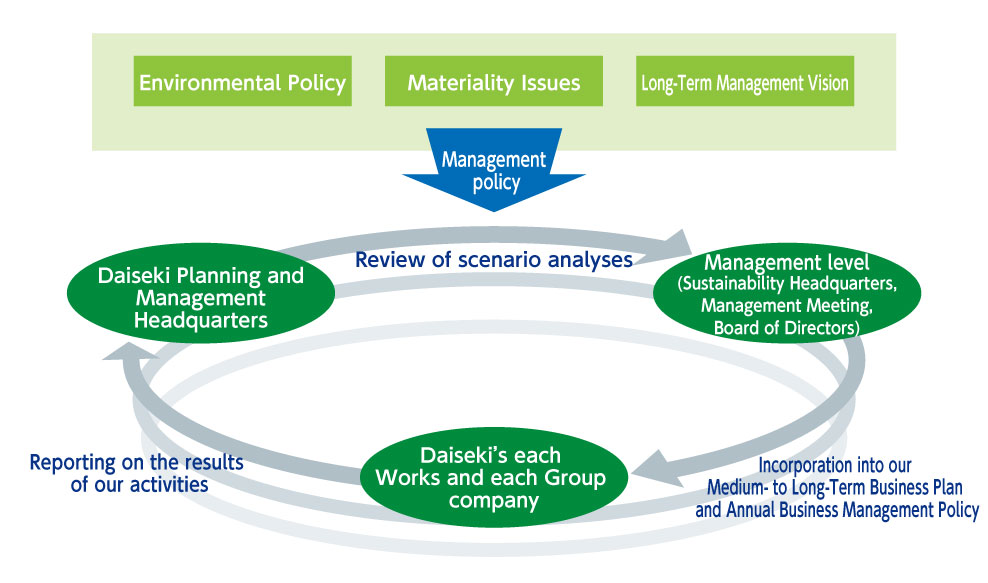Environmental management structure
The Daiseki Group engages in its business with a focus on the recycling of industrial waste, in line with the spirit of "no wastefulness" that we have carried forward since the foundation of the company. Recently, following the declaration of global goals such as the Paris Agreement and the SDGs, we revised our environmental policy in 2019. In 2022 we accelerated our efforts to achieve carbon neutrality, receiving SBT certification for our greenhouse gas emissions reduction target. In response to the growing need for carbon neutrality and a circular economy, we revised our environmental policy in July 2024. While providing support to manufacturing and other industries through our waste treatment service, the Daiseki Group contributes to the realization of a decarbonized and resource circulation-oriented society.
Environmental Policy
The Daiseki Group has established an Environmental Policy based on its management principles and in the spirit of the SDGs. Every company in the Group has established its own environmental policy based on the Group's shared core principles. Making our Environmental Policy known to all employees, we are working to achieve our goals as an environment-creating company.

Daiseki Group's Environmental Policy
Building of an environmental management system based on ISO14001

ISO 14001 Management System Registration Certifi cate
In 1998, Daiseki acquired its first ISO14001 certification at its Chiba Works. In 2006, we acquired a corporate-wide integrated ISO14001 certification and have successfully renewed the certification to date. Our domestic group companies also continuously engage in environmental conservation activities through the implementation of ISO14001 and Eco-Action 21.
The Daiseki Group has established an environmental management system delivering environmental management led by our President. Our Sustainability Headquarters, comprising Daiseki and our Group company management teams, deliberates on and makes decisions regarding priority matters concerning environmental protection and climate change. We also strive to continuously improve our environmental conservation activities by assessing, evaluating, and correcting the impacts that our business activities have on the environment.
Of the 49 sites of the Daiseki Group, 17 have acquired ISO14001 certification and 4 have acquired Eco-Action 21 certification.
Internal environmental audit and external environmental examination
Trained internal environmental auditors regularly conduct internal environmental audits to confirm compliance with the requirement items of ISO14001 or Eco-Action 21, after which relevant departments responsibility make improvements in line with the findings. Once a year, our president conducts a management review based on the findings of the internal environmental audits to confirm that the appropriateness, validity, and effectiveness of our organizations' management systems are being continuously improved. In addition, our company undergoes an external environmental examination by a certification body once a year. The certification body conducts on-site examination, written examination and interviews to check whether the requirement items of ISO14001 or Eco-Action 21 are surely executed. Thus, the Daiseki Group continues to maintain the certification by taking the external environmental examination.
Execution status of the internal environmental audit and external environmental examination
| FY2022 | FY2023 | FY2024 | |
|---|---|---|---|
| Number of business sites of the Daiseki Group | 41 | 42 | 49 |
| Number of business sites that have acquired ISO14001 or Eco-Action 21 | 19 | 21 | 21 |
| Number of business sites that conduct internal environmental audits |
15 *Four business sites that have acquired Eco-Action 21 are not applicable to internal audits. |
17 *Four business sites that have acquired Eco-Action 21 are not applicable to internal audits. |
17 *Four business sites that have acquired Eco-Action 21 are not applicable to internal audits. |
| Number of business sites that undergo external environmental examinations | 19 | 21 | 21 |
| Number of non-compliant cases pointed out by internal environmental audits | 1 | 6 | 4 |
| Number of non-compliant cases pointed out by external environmental audits | 0 | 1 | 1 |
Internal environmental audits
Trained internal environmental auditors regularly conduct internal environmental audits to confirm compliance with matters required by ISO14001, after which relevant departments take responsibility for making improvements in line with the findings. Once a year, our president conducts a management review based on the findings of internal environmental audits to confirm that the appropriateness, validity, and effectiveness of our organizations' management systems are being continuously improved.
Support for TCFD

The ”Task Force on Climate-related Financial Disclosures” (TCFD*1) established by the Financial Stability Board (FSB) calls on companies to disclose information related to climate change from the standpoint of investors, including information on climate-related risks and opportunities and clarification of governance-related information. In October 2020, we endorsed the recommendations of the TCFD and began an evaluation (scenario analysis*2) of the financial impacts of climate-related risks and opportunities on our management. Leveraging the knowledge we have acquired to date, we enhance our scenario analysis and examine countermeasures while engaging in information disclosure under the TCFD framework.
*1 TCFD: Task Force on Climate-related Financial Disclosures
*2 “Practical Guide for Scenario Analysis in Line with the TCFD Recommendations 3rd edition" (published March 2021, p. 235-247)
Management Strategy Based on Our Scenario Analysis

Sustainability Headquarters
In order to achieve business growth while mitigating our impact on the global environment, our Sustainability Headquarters, which is composed of executive officers including the Daiseki president and the presidents of Group companies, deliberates on policies to address environmental issues based on TCFD scenario analysis and monitors progress. Please refer to the organizational charts outlining our corporate governance system to find out more about the positioning of the Sustainability Headquarters within the Company.
Linking sustainability management results with compensation
Compensation for internal directors and executive officers follows a basic policy that links their compensation with shareholder profits as an incentive to sustainably increase corporate value and enhance the practice and promotion of sustainable management, and sets appropriate compensation levels for each director and executive officer based on their responsibilities. As an initiative to achieve SBTi targets, we establish internal emissions reduction targets for each Works based on ISO 14001. Directors and executive officers who achieve these Works targets receive stock-based compensation.
Environmental management structure
So that we can grow our business while reducing our burden on the global environment, our president, executive officers and Group company presidents who are the members of our Sustainability Headquarters deliberate policies for coping with environmental issues based on TCFD scenario analyses, and monitor our progress. The progress of deliberations by the Sustainability Headquarters is reported at Board of Directors meetings.









